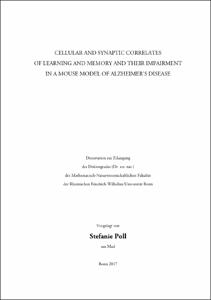Poll, Stefanie: Cellular and synaptic correlates of learning and memory and their impairment in a mouse model of Alzheimer's disease. - Bonn, 2017. - Dissertation, Rheinische Friedrich-Wilhelms-Universität Bonn.
Online-Ausgabe in bonndoc: https://nbn-resolving.org/urn:nbn:de:hbz:5n-49032
Online-Ausgabe in bonndoc: https://nbn-resolving.org/urn:nbn:de:hbz:5n-49032
@phdthesis{handle:20.500.11811/7298,
urn: https://nbn-resolving.org/urn:nbn:de:hbz:5n-49032,
author = {{Stefanie Poll}},
title = {Cellular and synaptic correlates of learning and memory and their impairment in a mouse model of Alzheimer's disease},
school = {Rheinische Friedrich-Wilhelms-Universität Bonn},
year = 2017,
month = nov,
note = {Alzheimer's disease (AD) is characterized by synaptic dysfunction and progressive memory loss. The hippocampus is indispensable for memory processes and early affected by disease-associated pathology. It is still debated how in particular encoding and retrieval of memories is impaired in AD. Therefore, the current study investigated how individual neurons in the hippocampus encode a memory and whether this process is disturbed under AD-like conditions in a pre-clinical model. To achieve this goal a cutting-edge technology – two-photon in vivo imaging – was used to repetitively analyze the activity of neurons in the hippocampus throughout a hippocampus-dependent memory test. Initially, this study revealed two populations of hippocampal CA1 neurons that differ in their long-term activity: a subset of neurons was continuously active over several days, whereas another population showed variable activity. The latter provided the population that responded to memory encoding as well as retrieval and hence, formed the cellular memory trace, also known as engram. Interestingly, network activity and engram formation under AD-like conditions (APP/PS1 mice) was intact. However, a further analysis of neurons composing the "retrieval network" identified an additional neuronal ensemble in CA1 that superimposed the memory trace suggesting a causal relationship of memory trace superimposition and memory impairment. Indeed, mimicking superimposition by artificial activation of a non-related memory trace coding a different context caused reduced memory performance in healthy mice and thus, presents a potential mechanism for impaired memory retrieval in APP/PS1 mice. Furthermore, parvalbumin-expressing (PV+) interneurons in CA1 were indispensable for successful memory encoding and retrieval in healthy mice. Their functional impairment represented a potential explanation of the observed engram superimposition in APP/PS1 mice. Finally, a learning-related loss of synaptic connections was discovered on dendrites of CA1 pyramidal neurons in healthy mice suggesting a mechanism of synaptic selection important for encoding of new information. Learning-induced changes of synaptic connectivity were absent in APP/PS1 mice indicating that synaptic connectivity deficits might be causally related to memory trace superimposition and ultimately memory impairment under AD-like conditions. Summarized, the present study provides a refinement of the engram's characteristics and furthermore, identifies a novel mechanism of memory impairment on the cellular and synaptic level in a enmouse model of AD.},
url = {https://hdl.handle.net/20.500.11811/7298}
}
urn: https://nbn-resolving.org/urn:nbn:de:hbz:5n-49032,
author = {{Stefanie Poll}},
title = {Cellular and synaptic correlates of learning and memory and their impairment in a mouse model of Alzheimer's disease},
school = {Rheinische Friedrich-Wilhelms-Universität Bonn},
year = 2017,
month = nov,
note = {Alzheimer's disease (AD) is characterized by synaptic dysfunction and progressive memory loss. The hippocampus is indispensable for memory processes and early affected by disease-associated pathology. It is still debated how in particular encoding and retrieval of memories is impaired in AD. Therefore, the current study investigated how individual neurons in the hippocampus encode a memory and whether this process is disturbed under AD-like conditions in a pre-clinical model. To achieve this goal a cutting-edge technology – two-photon in vivo imaging – was used to repetitively analyze the activity of neurons in the hippocampus throughout a hippocampus-dependent memory test. Initially, this study revealed two populations of hippocampal CA1 neurons that differ in their long-term activity: a subset of neurons was continuously active over several days, whereas another population showed variable activity. The latter provided the population that responded to memory encoding as well as retrieval and hence, formed the cellular memory trace, also known as engram. Interestingly, network activity and engram formation under AD-like conditions (APP/PS1 mice) was intact. However, a further analysis of neurons composing the "retrieval network" identified an additional neuronal ensemble in CA1 that superimposed the memory trace suggesting a causal relationship of memory trace superimposition and memory impairment. Indeed, mimicking superimposition by artificial activation of a non-related memory trace coding a different context caused reduced memory performance in healthy mice and thus, presents a potential mechanism for impaired memory retrieval in APP/PS1 mice. Furthermore, parvalbumin-expressing (PV+) interneurons in CA1 were indispensable for successful memory encoding and retrieval in healthy mice. Their functional impairment represented a potential explanation of the observed engram superimposition in APP/PS1 mice. Finally, a learning-related loss of synaptic connections was discovered on dendrites of CA1 pyramidal neurons in healthy mice suggesting a mechanism of synaptic selection important for encoding of new information. Learning-induced changes of synaptic connectivity were absent in APP/PS1 mice indicating that synaptic connectivity deficits might be causally related to memory trace superimposition and ultimately memory impairment under AD-like conditions. Summarized, the present study provides a refinement of the engram's characteristics and furthermore, identifies a novel mechanism of memory impairment on the cellular and synaptic level in a enmouse model of AD.},
url = {https://hdl.handle.net/20.500.11811/7298}
}






